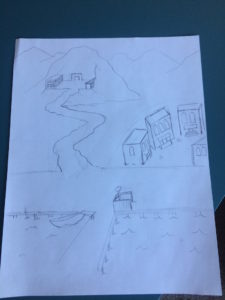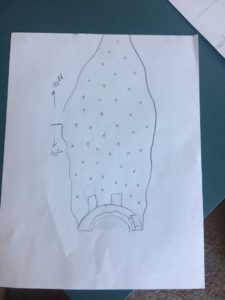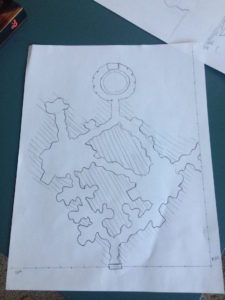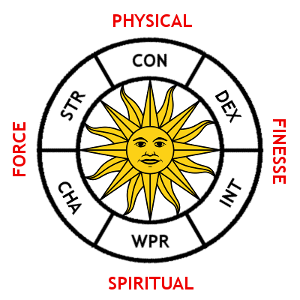My friend mentioned in this post wrote up her reflections on refereeing for the first time and even sent me the map sketches. Below the divider are her words. This could be an interesting case study for designers interested in what is useful to a new referee. And it sounds independently like a pretty great scenario.
When my little brothers (12-year old twins) told me they wanted to play when they came to visit me this past weekend, I was both excited to be introducing a new generation to the game I have recently come to love, but also more than slightly terrified at tackling the elusive role of DM.
I wasn’t too concerned about embellishing on the setting or the scenario, nor was I concerned with the edition rules and stats we would use since I planned on throwing most of them out anyway. I was more so worried about the behind-the-scenes mechanics of being a DM in real-time. Ultimately, how could I make this an epic one-shot with a climactic finale, without it feeling forced or coerced or like the players lost autonomy?
Naturally, I reached out to a DM friend, and he sent me this.
I found Michael Prescott’s dungeons to be quite inspiring for dungeon stocking and Dyson’s maps gave great suggestions for layout. The DM Information gave me the language I needed to conceptualize the concerns I had, and gave a really great straight forward and concise guide for how to build a dungeon without any waffling. I didn’t use any of the rolling systems for NPC creation or dungeon stocking, but the suggestions were inspiring.
What I ended up with was a mötley crüe of a game inspired by what I thought were either the most interesting or the most straight forward elements from the other DMs. I drew up a baby map, drew a picture of the town, and wrote up a short and dirty little summary of the key things the players may or may not encounter. Did it look or play like a 5e game? Heck no. But with a few exceptions it worked for me, and designing my own game gave me the peace of mind to improvise mid-play knowing I wasn’t going to miss anything “important.”
The game ended up looking something like this:
Scenario: The Athenian authorities are concerned with the sudden halt of raw silver deliveries from one of the most bountiful mining sites in the land. They are willing to pay handsomely for any adventurer who can get production going again. Upon arriving at the island, players learn that silver shipments have stopped because the miners are refusing to enter the mines. For the last 3 weeks, anyone who has entered is never seen again.
 Setting: 4th/5th Century BCE Greece, in a mining town on the island of Thassos. Options to explore included the marina, the little mining town, a set of miner barracks outside the entrance to the mine, and of course – the mine itself. In hindsight, grounding the game in non-fiction was probably the best decision I made for players with little to no exposure to fantasy/sci-fi. I knew they’d have at least a basic understanding of ancient Greek mythology and folklore, so the ideas and objects they’d encounter would have natural affordances for future action without requiring too much exploration or coercion.
Setting: 4th/5th Century BCE Greece, in a mining town on the island of Thassos. Options to explore included the marina, the little mining town, a set of miner barracks outside the entrance to the mine, and of course – the mine itself. In hindsight, grounding the game in non-fiction was probably the best decision I made for players with little to no exposure to fantasy/sci-fi. I knew they’d have at least a basic understanding of ancient Greek mythology and folklore, so the ideas and objects they’d encounter would have natural affordances for future action without requiring too much exploration or coercion.
Special Monsters: This was by far the most fun. Following naturally from an ancient Greek setting, the players would eventually find out that the mine was having problems because recent activity disrupted the centuries-old prison of Phobos (God of Fear) and Deimos (God of Terror), twin sons of Ares and Aphrodite. Their sister – Adrestia (Goddess of Revenge), had lured them to the island and captured them in a tomb in retribution for the fear and terror they had caused her as a child. In search of strength, Phobos and Deimos had been luring miners into their prison and turning them into undead acolytes (complete with eyes sewn shut and ominous chanting- terrifying imagery for 12 year olds!)
Setting up the monsters as part of the story in this way was both limiting and freeing. On the one hand, since the monsters were there for their own reasons, they didn’t necessarily have to kill or even fight my players (thanks, Brendan ☺). This gave both the players and me the flexibility to have an ending that played out however it wanted to. However, this setup also relied on the players getting the information they needed beforehand to make that choice. Overall, this ended up working really nicely. The players got the information they did, and formed lay theories to fill in the missingness. This lead to an ending that was as much of a surprise to me as it was to them.
I had hidden some crawling claws and shadows in storage alcoves in the mines, but no one explored these. Also, a swarm of spiders came into unplanned existence from a bleeding cave wall when one of my players seemed to have decided he would rather mine for silver all day than finish the quest 😉
 Map: Super simple. The most complex thing was the final room where Phobos and Deimos were imprisoned. I took inspiration for this room largely from the great hall in Michael Prescott’s map, “The Chain of Heaven.” The room ended up being a 180-foot cylindrical cavern mirrored in silver ore, with a hole 90 feet up where the miners had originally broken through and disturbed the prison. At the base of the cavern was a shallow pool surrounded by an earthen ledge. Otherwise, the map had 2 other larger rooms and a few alcoves connected by hallways, and I suppose the town and marina count as part of the map too. Note to self for the future: long hallways leading simply from A to B with nothing in between are a waste of time and space.
Map: Super simple. The most complex thing was the final room where Phobos and Deimos were imprisoned. I took inspiration for this room largely from the great hall in Michael Prescott’s map, “The Chain of Heaven.” The room ended up being a 180-foot cylindrical cavern mirrored in silver ore, with a hole 90 feet up where the miners had originally broken through and disturbed the prison. At the base of the cavern was a shallow pool surrounded by an earthen ledge. Otherwise, the map had 2 other larger rooms and a few alcoves connected by hallways, and I suppose the town and marina count as part of the map too. Note to self for the future: long hallways leading simply from A to B with nothing in between are a waste of time and space.
Stock: I decided to keep the role-playing and potential combat areas separate, allowing for information gathering in the first half of the game, and exploration/combat in the second half. In hindsight, the game probably would have been more complex and interesting if these things were mixed, but for the sake of story telling and introducing players slowly into game mechanics, it worked pretty well. I also kept treasure to a minimum given this was a one shot game.
Marina/Mining Town/Barracks: This is where the players could gather information. There were 5 main sources planned, and the players ended up getting 4 of them. A marina keeper directed them to important folk in the town. The last two men out of the mine (one of whom went mad) gave them the run down on the last thing they saw before fleeing the mines. They spoke to Bion, the local philosopher and historian, about the Gods. Finally, they spoke to a miner’s son, who swore he could hear his father’s voice from the mine at night.
 Mines: Nothing too exciting in any of the other rooms except for a bunch of abandoned miner tools and the monsters that no one found. The walls of the mine bled if axed. The first main obstacle in the prison was the 90-foot drop to the bottom. Also, the pool couldn’t be looked at directly without risking mind-control, but indirect looking via the mirror-like silver walls revealed two glowing human-heart-shaped orbs at the base of the pool. There were 4 doorframes around the perimeter of the cavern, behind which were small alcoves. In the event of a pool disturbance, these alcoves filled with apparating undead acolytes who didn’t attack unless provoked, but chanted menacingly about a choice that had to be made. At one end of the cavern was a large sacrificial platform, upon which were a golden gong and a black dagger. Both the gong and the dagger were ornately carved in patterns unrecognized by any of the party, but seemed weathered and tarnished with age. I had originally intended a blood sacrifice with the dagger to wake Phobos and Deimos, and a ringing of the gong to summon Adrestia, but of course – neither of these things happened and Adrestia still showed up!
Mines: Nothing too exciting in any of the other rooms except for a bunch of abandoned miner tools and the monsters that no one found. The walls of the mine bled if axed. The first main obstacle in the prison was the 90-foot drop to the bottom. Also, the pool couldn’t be looked at directly without risking mind-control, but indirect looking via the mirror-like silver walls revealed two glowing human-heart-shaped orbs at the base of the pool. There were 4 doorframes around the perimeter of the cavern, behind which were small alcoves. In the event of a pool disturbance, these alcoves filled with apparating undead acolytes who didn’t attack unless provoked, but chanted menacingly about a choice that had to be made. At one end of the cavern was a large sacrificial platform, upon which were a golden gong and a black dagger. Both the gong and the dagger were ornately carved in patterns unrecognized by any of the party, but seemed weathered and tarnished with age. I had originally intended a blood sacrifice with the dagger to wake Phobos and Deimos, and a ringing of the gong to summon Adrestia, but of course – neither of these things happened and Adrestia still showed up!
Compared to some of the games I’ve played as a player, this is really sparse stocking. I was worried about that before we started, but it actually worked well for a 3 hour game with young and brand new players because 1) it allowed for a focus on building a transporting story more than a game with treasure splitting, repetitive combat, and/or undirected information seeking would have allowed, and 2) the sparseness afforded elaboration on all the elements in an environment together– everything in the room had a purpose, and it was up to the players to figure out (or, in some cases, tell me!) what that shared purpose was. If I were doing this again, I’d say this amount of stocking is just about right.
Mechanics: In terms of game mechanics, since my players were brand spanking new to the game and I was already worried enough about keeping the dungeon straight, I knew I’d want to keep them as simple as possible. This meant getting rid of alignment and 5e backgrounds. We didn’t track movement. Skill checks were only used when whatever they wanted to check was unexpected and I needed a few extra seconds to invent something plausible. I actually found structuring combat with initiative was really helpful. The players got super excited about how they were going to kill the thing, so being able to go through a list systematically was a good way to keep things straight.
In hindsight, I wish I had simplified even more. Even the skills-only character creation process took nearly an hour and already had one of my players thinking DnD was complicated. If I could go back, I would consider getting rid of race and skills and just using the appropriate ability checks for skill checks.
Final Details: The best lesson came in the form of a logical anomaly in play. I accidentally made the opening to the final prison much smaller than would have been possible given other information they had. My mom pointed this out, and as I’m wracking my brain for a semblance of a plausible explanation for this anomaly, my brother turns to my mom and says, in a tone only a 12 year old can pull off, “DUH!! If the walls can bleed of course they can heal!” Not only a perfectly plausible explanation- but way better than anything I would have come up with! I somehow managed in my shock to put an all-knowing DM smile on my face as the players moved on to break down the wall. The moral of the story – it’s often best to just shut up for a second and let your players do the talking.
Overall, DM’ing was a fantastic experience that I would love to do again. While it was a bit nerve wracking to get started, once I had hooked on Phobos and Deimos the rest kind of fell into place and I ended up with this cute baby dungeon that I was quite literally giddy with excitement to have the players explore.
I loved seeing the different personalities of my players, and listening as they elaborated with such creativity on the tasks I had designed for them. My one brother was super into role-play and kicked ass at getting information out of people. Unfortunately he also had a penchant to jump into situations without thinking, which lead to near death quite a few times. Luckily, my other brother had the most ingenious ways of using his spells to make combat virtually irrelevant, and it was absolutely hilarious hearing my mom use vicious mockery to kill a swarm of spiders.
Oh, and the players loved it ☺ My brother bought his first set of polyhedrals the next day, and we played a second game that night!
Game Notes
A marina town in ancient Greece on the island of Thassos, a mile or so south of a silver mine. Rumors are that the Gods had spited the mine, as miners had mysteriously been disappearing and random wails of the men who worked there can often be heard at night.
The miners refused to show up to work in protest, so the Athenian authorities promised significant reward to anyone who would enter the mine to appease the Gods. They were losing a lot of money from the stalls in the silver trade.
Dock
NPC – Marina Keeper (Trechus the Keeper) – repeats the intro.
If asked: Says that it seems to have started about 3 weeks ago, when two miners (Nilus and Kittos) ran out of the mine in Terror. Nilus has gone mad and is being housed in the infirmary. Kittos hasn’t left his side since the incident. From that day, anyone who has entered the mine has not returned. They called in Bion the local theologian to
Town
Bookshop, Infirmary, Market, Bar, Inn
NPCs – Nilus, Kittos, Bion
Nilus wailing: The pool! OH the Horror, Oh Phobos, Oh Deimos, my fear, my terror!
Kittos: The miners had recently broken ground into a cavern they hadn’t seen before – the cavern was larger than they had ever seen, and unusual for the rock formations found in the mine. Oddly, the cavern was basked in a pool of light seemingly emanating from the sparkle of more silver embedded in the walls than any of the miners had ever seen before. This was a great find, and since the miners get to keep a small portion of whatever silver they find, Kittos and Nilus thought they would be rich. Kittos was behind Nilus when they broke through, and could see the silver in the wall, but only Nilus looked in, yelled at the splendor of the room, and then started screaming in terror. Kittos yanked him back and ran out of the mine, and Nilus has been wailing these words ever since.
Info (if you can calm Nilus’ Horrors somehow): At the base of the cavern was a pool of water. The rubble from knocking through the wall disturbed the pool. When Nilus looked in the pool, his greatest fears and terrors ripped through him.
Bion: Knows the myth about Phobos and Deimos being coerced by their sister Adrestia to the island of Thassos, where she trapped them in a tomb to save her and her brothers (Eros and Anteros) from the troubles of horror.
Miner Camp
Miners are congregated out in the pavilion beside, playing games and drinking because they refuse to go in – you can talk to them and get more info if you really wanted to, but it seems they don’t know much except about the wails late at night, and this constant echo sound like chanting from deep within. Even the vermin have fled.
The son of one of the guys who went in swears he hears his dad in the wailing.
Mines
NPCs – Lots of Monsters: Cultists, Gods, Gross Hands
GONG – If they ring the gong on the big table, the room starts shaking, the cultists chant louder and the pool begins wavering, but then Adrestia appears and stills the pool.
DAGGER – If they offer a blood sacrifice on the tomb, they awaken Phobos and Deimos and basically die.






